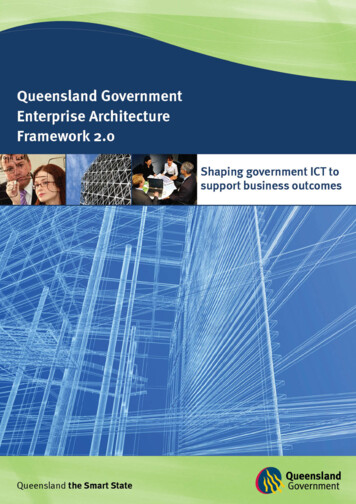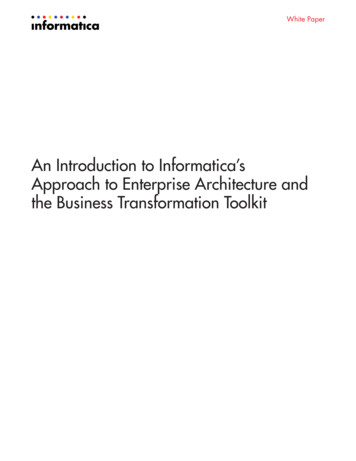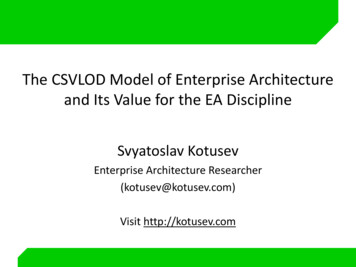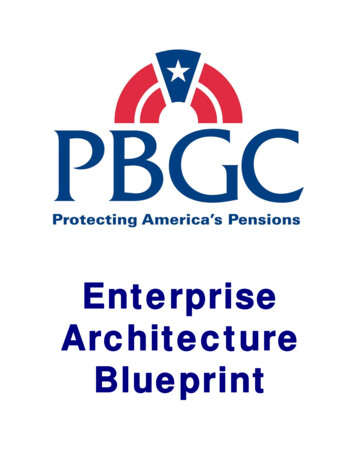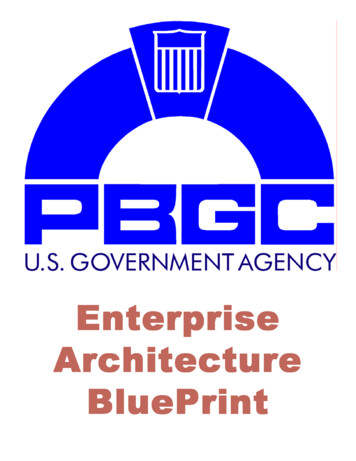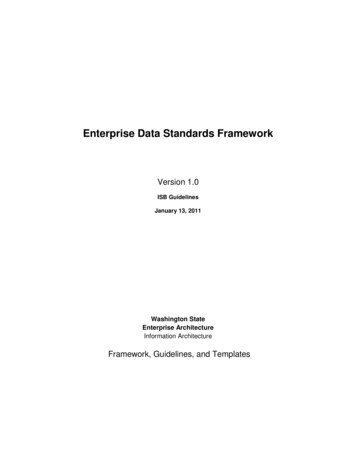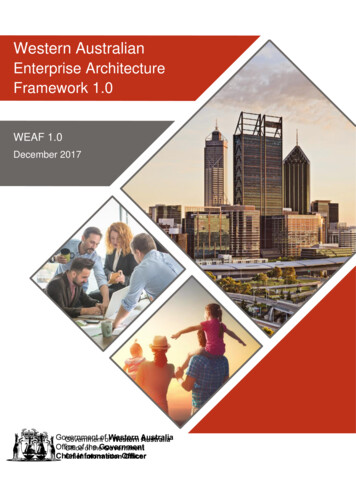
Transcription
Western AustralianEnterprise ArchitectureFramework 1.0WEAF 1.0December 2017
This document, the Western Australian Enterprise Architecture Framework, Version 1(WEAF 1.0) is licensed under a Creative Commons Attribution 4.0 International Licence.You are free to re-use the work under that licence, on the condition that you attribute theGovernment of Western Australia (Office of the Government Chief Information Officer) asauthor, indicate if changes were made, and comply with the other licence terms.The licence does not apply to any branding or images.License URL: odeAttribution: Government of Western Australia (Office of the Government ChiefInformation Officer) 2017Notice Identifying Other Material and/or Rights in this Publication:The Creative Commons licence does not apply to the Government of Western Australia Coatof Arms. Permission to reuse the Coat of Arms can be obtained from the Department ofPremier and Cabinet.Produced and published by: Office of the Government Chief Information Officer (WesternAustralia) 2017.Acknowledgements This framework was developed in collaboration with WesternAustralian public sector agencies.Enquiries:Office of the Government Chief Information OfficerDumas House, 2 Havelock Street, West Perth 6005Locked Bag 11 Cloister Square, Perth WA 6850Telephone: (08) 6551 3900Email: enquiries@gcio.wa.gov.au Website: www.gcio.wa.gov.au
Table of ContentsContext .1Introduction .2Key Drivers .2Composition .31.Defining Enterprise Architecture Framework .51.1 Enterprise Architecture Definition .51.2 Enterprise Architecture Framework Attributes .52.Overview.73. Architecture Domains .84. Deliverables .94.1 Future State Architecture Views . 104.2 Current State Architecture Views . 124.3 Enterprise Roadmap . 134.4 Content Metamodel . 154.5 Architecture Repository . 165. Elements . 175.1 Metrics . 175.2 Governance . 185.2.1Architecture Review Board . 185.2.2 Architecture Compliance . 195.2.3 EA Governance Structure for WA Agency . 205.3 Principles . 215.4 Method . 215.5 Tools . 245.6 Reference Models . 255.7 Standards. 265.7.1 Reference Architectures . 265.8 Reporting . 27
6. Enterprise Architecture Services . 296.1 Problem. 296.2 Benefit . 296.3 Enterprise Architecture Services Overview for WA Public Sector . 306.3.1Assist with Business Strategy and ICT Strategy . 316.3.2Application Portfolio Rationalisation . 326.3.3 Enterprise Architecture Planning and Actionable Enterprise Roadmap Development . 346.3.4 Project Prioritisation Advice to Help Driving Business Forward and Improve ProgramOutcomes . 346.3.5Business and ICT Initiatives Development . 356.3.6Standards Establishment and Architecture Governance . 356.3.7Solution Architecture Guidance and Oversight . 366.3.8Architecture Patterns and Reusability . 367. Enterprise Architecture Skills . 387.1 Skills Development Maturity Roadmap . 387.2 Reason for Defining an Enterprise Architecture Skillset . 397.3 Identified Skillset . 407.3.1Communication skills . 407.3.2Presentation and public speaking skills . 407.3.3Rapport building and networking . 407.3.4Innovation and creativity . 417.3.5Art of influencing – the Trusted Advisor . 417.3.6Leadership skills . 417.3.7Decision-making . 417.3.8Negotiating Skills . 427.3.10Managing Time and Competing Deadlines . 427.3.11Assertiveness . 427.4 Comparative Analysis against Industry Skill Frameworks . 437.4.1Mapping of Desired Skillset against TOGAF Matrix . 437.4.2Mapping of the desired skillset to SFIA Skills Category . 447.5 A Recommended Minimum Sector Wide Skill Requirement . 45
7.5.1Occupational/Profession Specific Capability . 457.5.2Occupational/Profession Specific Capability - Detailed Description . 46Appendix A – Government Enterprise Architecture Workgroup (GEAW) . 49Members . 49Consultative Process . 49Appendix B – Digital WA Strategic Principles . 50Appendix C – TOGAF Proficiency Level . 52Appendix D - Acronyms . 54
ContextThe Digital WA: Western Australian Government ICT Strategy 2016-2020 (the Digital WAStrategy) is the result of consultation across the public sector and Information andCommunications Technology (ICT) industry. It positions the public sector as a whole toleverage the opportunities presented by current and emerging technologies to deliver efficient,reliable ICT services that support exceptional public services.An important part of the Digital WA Strategy is the development of an Enterprise Architecture(EA) framework for use across the public sector with the purpose of leveraging the combinedICT capability of all agencies. An EA framework will support the Digital WA Strategy byinforming, guiding and supporting agencies in the delivery of government services.A tailored EA framework will promote policies and practices that will assist agencies to: Inform and be informed: on what ICT capabilities (people, processes, informationand technologies) are available across the entire public sector by contributing to andbuilding on cross sector capabilities. Guide and be guided: by contributing to and utilising principles, policies, processesand standards that promote agencies working together to achieve whole-ofgovernment- goals as well as leverage agency capabilities across the sector to moreefficiently deliver services. Support and be supported: assist and advise agencies on tools, techniques andinformation on how to best deliver services more efficiently at a lower cost and higherquality to the citizens of Western Australia and deliver strategic public sector outcomes.Figure 1 – Strategic ContextFigure 1 has been sourced directly from the Digital WA Strategy. Its purpose is to provide awhole-of-government strategic context on where the Digital WA Strategy is aligned with othergovernment strategic plans. This document uses the diagram to depict where EA will providevalue (blue arrows) in the areas of Informing on Agency Strategy, Guiding Agency ICTStrategy and Supporting Agency Projects and Operations.1
In line with the approach the Digital WA Strategy has taken, the Office of the GovernmentChief Information Officer (OGCIO) will continue to collaborate across the public and privatesectors throughout the life of the Digital WA Strategy to ensure that the development of theEnterprise Architecture capability remains relevant, effective and achievable.IntroductionIn August 2016, an inter-agency workgroup was setup within the OGCIO to develop theWestern Australian Enterprise Architecture Framework (WEAF). The group was named theGovernment Enterprise Architecture Workgroup (GEAW)1.The WEAF is designed to guide the implementation of effective EA functions within theWestern Australian public sector. The resulting EA deliverables and services will assistagencies to deliver strategic outcomes with a lower total cost of ownership, faster time todelivery and reduced duplications within each Agency and across the sector.Key DriversThe key drivers for developing the WEAF were: Provide an EA framework to support delivery of the Digital WA Strategy. Involve public sector agencies early to encourage collaboration and facilitateconsultation. Continuous engagement will likely secure agency buy-in and support forWEAF. Improve the maturity of Government’s EA capability. For the majority of WA publicsector agencies, the maturity level of their current EA capability is low. Provide a blueprint for an EA function based on widely-used industry EA frameworks,and be mindful of providing a structure that allows agencies with established EAfunctions to easily align with WEAF. Leverage work already performed by another state, regional, national and internationalorganisations regarding EA and associated policies, procedures and guidelines. Maintain compatibility with Australian Government Architecture (AGA) and FederalEnterprise Architecture Framework (FEAF) reference models to leverage these wellestablished frameworks and facilitate national and interstate collaboration. Utilise a consolidated set of principles to make fully supportable and consistentinformation technology investment decisions within the WA public sector that align withthe achievement of business and government goals.1The GEAW is comprised of EA practitioners and/or representatives from 7 WA government agencies.Membership of the GEAW and its consultative processes are captured in Appendix A.2
Support the delivery of both short-term improvements that provide a quick return oninvestment and longer-term strategic improvements that provide more substantialvalue over time for an agency and the government. Focus on creating actionable deliverables that will be used in agency and whole-ofgovernment decision-making rather than just “shelf-ware”.CompositionWEAF consists of the following major components, which when used together will assist inthe delivery of an effective EA function across the public sector: EA Framework: defines how to create and use an Enterprise Architecture. WEAF willprovide structure for the establishment and implementation of relevant and actionableEA deliverables at whole-of-government and agency level. EA Services: to facilitate consistent and uniform implementation of EA functionsacross and within agencies, WEAF recommends that agencies develop EA capabilitiesto provide eight defined services (described in section 6 of this document) at a level ofmaturity that is appropriate for the agency. This service catalogue approach to EA workis intended to increase the focus of EA functions on agency performance while takingthe confusion out of what services Enterprise Architects (EAs) should be providing. EA Skills: to deliver the effective EA services, WEAF identifies eleven skills that applyto someone undertaking the role of Enterprise Architect within the WA public sector.These skills have been mapped against two industry standard skills frameworks(TOGAF and SFIA). WEAF recommends that these skills are the minimum requiredfor an EA role to be effective. They should be incorporated into the job descriptions ascore competencies of those undertaking the EA role. Reference Architectures: Reference Architectures (RA) are the means through whichWEAF provides repeatable architecture designs based on industry best-practice tobuild common business and technical capabilities. They will be developed as commonor shared solutions across the sector. They provide a key mechanism to preventunchecked acceptance of too many different (or duplicate) solutions for the samegovernment service; they assist in the promotion of a coordinated whole-ofgovernment approach to delivering agency services to the community and can reducepotential increases in the support and maintenance costs of the public sectors ICTinvestment.WEAF will assist agencies to improve their business and ICT capabilities by promotinginteroperability, information sharing and cross-agency collaboration for reusable and multitenanted platform services and the development of common business processes, services,functions and technical components.WEAF has leveraged several best practices of widely adopted industry Enterprise Architectureframeworks and standards. This includes, but is not limited to the United States Federal3
Enterprise Architecture Framework (FEAF), The Open Group Architecture Framework(TOGAF), Australian Government Architecture (AGA) framework and publications andstandards from the National Institute of Standards and Technology (NIST), Harvard BusinessPress and Gartner Inc.Agencies that have been or are currently developing Enterprise Architecture functions, in themajority of cases, will be able to align to WEAF. This will minimise rework and allow agenciesto build on what they have already implemented to date.The following sections of this document describe WEAF. Section 1: provides EA definition in the context of the WA public sector, it defines anEA Framework and the characteristics it should exhibit. Section 2: provides an overview of the EA framework as defined by WEAF. Section 3: provides a quick overview of architecture domains. Section 4: describes the actionable EA Deliverables that are the main focus of anagency based EA function and its structure provided by WEAF by using a mature, wellunderstood Content Metamodel. Section 5: describes the eight basic elements of WEAF that guide, support and governthe development of these actionable EA deliverables. Section 6: describes eight services that all agency EA functions should offer. Section 7: identifies eleven minimum skills required for an EA role within the WA publicsector.4
1. Defining Enterprise Architecture Framework1.1 Enterprise Architecture DefinitionThere are many definitions of Enterprise Architecture; all focus on providing a holisticdescription or view of the organisation under review. All analyse the structures, activities,goals, vision and objectives of the organisation to provide greater understanding for relevantand divergent stakeholders by presenting multiple views and viewpoints.The general goal of Enterprise Architecture is to improve an organisation’s performance inreaching their goals through better investments in people, process, information andtechnology. Enterprise Architecture is also a way of describing the structure, functions,relationships and performance of an organisation.The following has been put forward as a definition of Enterprise Architecture (EA) within thecontext of Western Australian government;“The purpose of Enterprise Architecture is to enable the Western Australian publicsector to realise its strategic goals through better service delivery of communityservices, while enabling it to respond to change and increasing its effectiveness, agility,durability, efficiency, reliability, trust and quality while reducing costs and risksByStrategic Planning, Collaboration, Influencing and Governance supported by adecision support framework to allow senior decision makers across the public sectorto make more informed decisionsUsingThe Principles, Models, Guidance, Processes and Tools for the WEAF”1.2 Enterprise Architecture Framework AttributesAn EA framework defines how to create and use an Enterprise Architecture typically byproviding blueprints, structures, common language, methods, tools and templates with theintent of achieving business objectives in alignment with an organisation’s overall strategy.Given its importance for business sustainability, there are a lot of EA frameworks availableand in use by various organisations in both the public and private sectors. Some of thoseframeworks are specifically designed to support a multitude of organisations in multipleindustries and include comprehensive methods, tools and implementation guidelines. Someof the other frameworks are intended to simplify the initiation of an EA function, and someother frameworks provide generic or sector specific taxonomies to provide a commonlanguage.Prescribing or enforcing a single type of EA framework is not the primary purpose for WEAF.Rather, its intent is to support the Digital WA Strategy and to meet the specific needs of the5
Western Australian Public Sector by using Enterprise Architecture best practices and sharingthe collective lessons learned by agencies.From the WEAF point of view, the following characteristics are what an EA framework shouldpossess: Comprehensive: an EA framework should cover all aspects of an agency. It achievesthis by providing clarity on the current and future views of the agency’s performance,business, services, data and technology. It supports incremental development throughlines of business (agency purpose and business unit functions), Segments (targetedlines of business that slices through architecture domains) or Domains (see section 3.Domains for more details). Integrated: an EA framework should provide a mechanism (e.g. content metamodel)that documents the relationships among architecture components within the domainsof performance, business, services, data, and technology domains and their alignmentto agency and whole-of-government strategic goals. Scalable: an EA framework should support architecture practices at variousorganisational levels and scopes (i.e. can be applied at; whole-of-government, crossagencies, agency, line of business, segments, capability, etc.). Flexible: an EA framework should be adaptable to change and accommodate differentapproaches to the implementation of an EA function. It should provide the flexibility tosupport architecture practices using a top-down (business-driven) approach where thefocus is on the strategic planning value of EA. Or a bottom-up approach (initially drivenby the need to improve ICT efficiencies and standardisation) to enable architectureteams to start small, demonstrate the operational value of EA in order to gain executivesupport and then incrementally expand the scope and focus of EA over time. Standards and Reusable Assets: an EA framework should provide and identifyreusable standards including best-practice-based architectural designs (such asReference Architectures) to build and document common business and technicalcapabilities.6
2. OverviewThe Western Australian Enterprise Architecture Framework (WEAF), illustrated in Figure 2below, is closely aligned with the AGA. To understand WEAF, it is necessary to understandthe components that make it up. Each of these components by themselves does not add value;it is only when they are used together to provide a complete picture or solution can meaningfulvalue be delivered to stakeholdersFigure 2 – WEAF overviewDiscussing the components from the outside-in, we have the following: Architecture Elements: methods and processes that guide, support and govern thedevelopment of EA deliverables. WEAF has eight elements; these are; Metrics,Governance, Principles, Methods, Tools, Reference Models, Standards2 andReporting. Architecture Domains: allow agencies to view themselves in terms of their strategicgoals and the business services, processes, information, applications and theunderlying technology that supports them. There are five domains within WEAF;Performance, Business, Services, Data and Technology. EA Deliverables: are outputs produced from the Architecture domains. They are usedby agency executives in their portfolio planning, decision-making and resourceplanning to achieve strategic business outcomes.Note that “Standards” as WEAF element (refer to section 5.7 Standards) is different to “Standard”as an example of outputs identified within Technology domain (which is based on the AGA referencemodels - refer to section 5.6 Reference Models).27
3. Architecture DomainsAn architecture domain is an abstract view of an organisation that provides stakeholders ofEA with the ability to see the organisation through different lenses. Depending on the lensbeing used, it allows for the use of specific analysis and modelling to be undertaken at therequired depth to provide clarity on how the organisational component is used and contributesto the goals of the organisations.WEAF leverages on and conforms to the AGA. It adopts the following five architecturedomains; Performance, Business, Services, Data and Technology.Performance domain is focused on designing and implementing effective businessmeasurement systems and performance architectures. It identifies measurement needs,describes the types of measurement that can support identified needs and define effectivemeasurement indicators.Business domain provides a taxonomy for classifying a functional (as opposed to anorganisational) view of an agencies’ Line of Business (LoB). It articulates the capabilitiesrequired for achieving the desired performance outcomes and business objectives and linksthe capability through to the supporting business processes.Service domain serves to identify and classify horizontal and vertical service components thatsupport agencies and their ICT investments and assets. Service architecture encapsulatesbusiness services, applications, application capabilities and components.Data domain serves to identify and classify data assets and supports information sharing andreuse across the public sector. It promotes uniform data management practices by enablingagencies to agree, establish and support a common language and standards for informationsharing.Technology domain is component-driven, technical framework categorising the standardsand technologies used to support and enable the delivery of business functions and services.Each domain can impact or influence the others. For example, the Business drives what theServices are, but at the same time, the Business is dependent on the Services to operate andachieve its goals.8
4. DeliverablesThere is the tendency for EA practitioners to focus heavily on producing operational EAdeliverables (‘doing EA’) that are useful to Enterprise Architects or Solution / DomainArchitects. These deliverables are required to define, communicate and run EA functions, butthey may not be perceived as valuable by senior management or do not directly respond tospecific business and ICT requirements.WEAF attempts to strike a better balance by maintaining and expanding the focus of agencyand cross-agency EA functions to creating actionable EA deliverables. Actionable in a waythat the architecture analysis, artefacts and documentation can also be used by executives,managers, and staff to support and improve portfolio planning, resource planning anddecision- making. Actionable deliverables have a direct relationship to strategic goals andbusiness requirements, and they drive change towards the desired future state of the agency.The WEAF identifies the following actionable deliverables as the minimum set of coreartefacts;1. Future State ArchitectureA view that represents the target state architecture of an organisation, within thecontext of the strategic goals of an agency and its operating model.2. Current State ArchitectureA view that represents the current state (baseline) architecture of an organisation. Anorganisation cannot start transformation process without knowing its starting point.3. Enterprise Architecture RoadmapA guide that contains a necessary set of actions to transform the organisation from itscurrent state architecture to its target state architecture.Figure 3 below illustrates the recommended minimum set of EA deliverables.Figure 3 – Minimum Enterprise Architecture Deliverables.9
Both the Current State Architecture and Future State Architecture can be thought of as twoviews of the same organisation at different points in time. They can take the form of a set ofinterconnected models that support better planning, decision-making and management bothwithin an agency and whole-of-government strategic initiatives. These models describe therelationship between an organisation’s strategic goals, business functions, information andenabling applications and technologies in an explicit and manageable way.The Enterprise Architecture Roadmap and the two views provide a picture of the architectureregarding what exists currently, what is planned for the future, and what programs, projectsand initiatives constitute an enterprise roadmap to transition the agency to the future statearchit
This document, the Western Australian Enterprise Architecture Framework, Version 1 (WEAF 1.0) is licensed under a Creative Commons Attribution 4.0 International Licence. . An important part of the Digital WA Strategy is the development of an Enterprise Architecture (EA) framework for use across the public sector with the purpose of leveraging .

